Writing a new future
Epcot’s first certifiable thrill ride was a hit. For better or worse, the “runaway” success of Test Track signaled the beginning of the end for Epcot’s opening day philosophy. The park, it was now clear, was bound by neither nostalgia nor the future. Test Track successfully blended into the park’s industrious roots while proving that this new version of the park could support thrill rides. Sure, it stuck out like a sore thumb… but that was the point.

Though it’s frustrating for fans, the truth is that Epcot did need to change; if it were still a park made of monumental ’70s and ’80s brutalist pavilions populated by 15-minute dark rides sponsored by corporations, it would probably be considered an embarassment. Test Track revealed a new path forward. And so, the dominoes fell. World of Motion’s 1996 closing kicked off an aggressive new philosophy.
- Nearby, the Lost Legend: Universe of Energy was “upgraded” to include stars from Disney’s recently-acquired ABC, becoming Ellen’s Energy Adventure;
- Just two years later, another Lost Legend: Journey into Imagination was given a 21st century reboot (becoming one of Disney’s most embarrassing rides ever);
- A neighboring Lost Legend: Horizons became the nauseating (and frankly, brainless) Mission: SPACE in 2003, born of the same mindset as Test Track;
- The Land became home to an East Coast cousin to another Lost Legend: Soarin’ in 2005 – again, evidence of a new path for the park.
There was no stopping it. Epcot was destined to leave its storied, scientific roots behind to become Disney World’s “discovery park” of slightly-scientific thrill rides. You might consider Test Track the first of the park’s “New Millennium” graduating class…
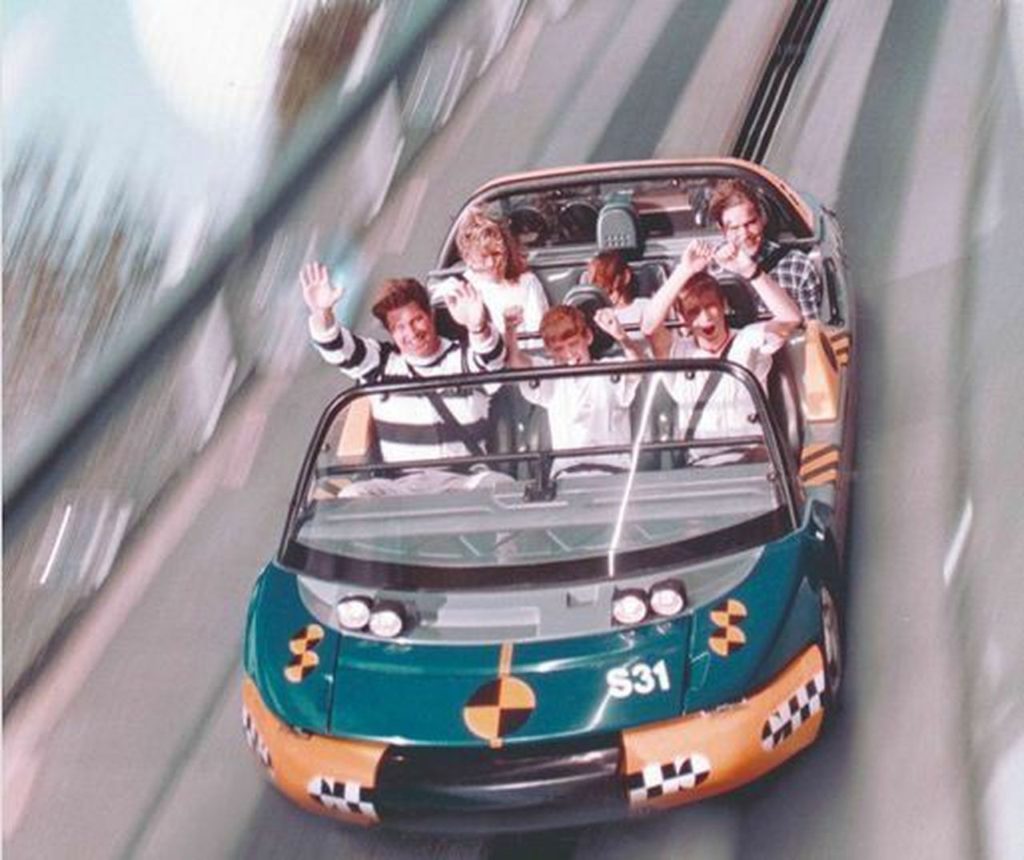
… Which is why the announcement of its closure just thirteen years later was entirely unexpected. On April 15, 2012, Test Track closed.
However, the ride wasn’t dead. Instead, Imagineers announced that it would re-open in Fall 2012 as an entirely new version. This 2012 redesign was staggering in its scope… so much so that we contest that it’s a replacement more than a reimagining, as the ride that came out the other side not only looks and feels different, but also has a different purpose. That’s why we bestow Test Track’s 1999 – 2012 form with venerated Lost Legend status, remembering it here as a landmark ride that, for all intents and purposes, is gone.
Inside, an entirely new ride was taking shape.
TEST TRACK: Take 2

The new ride that debuted in 2012 might not look very different from the outside. As before, every few seconds the high-pitched electric hum of a car approaches from the left, roaring – out of sight – around the banked track that encircles the pavilion.

You might notice that the logo now reads Test Track Presented by Chevrolet, as GM has specifically selected its Chevrolet brand as the ambassador here. But otherwise, what could have changed?
Inside, everything has. You’re no longer in a warehouse. The “construction zone” motif is gone. There’s no indication whatsoever that you – or anything else here – will be a crash test dummy in an industrial safety test. Instead, you’re in a streamlined, sleek showroom where the newest of GM’s Chevrolet prototype vehicles are on display…
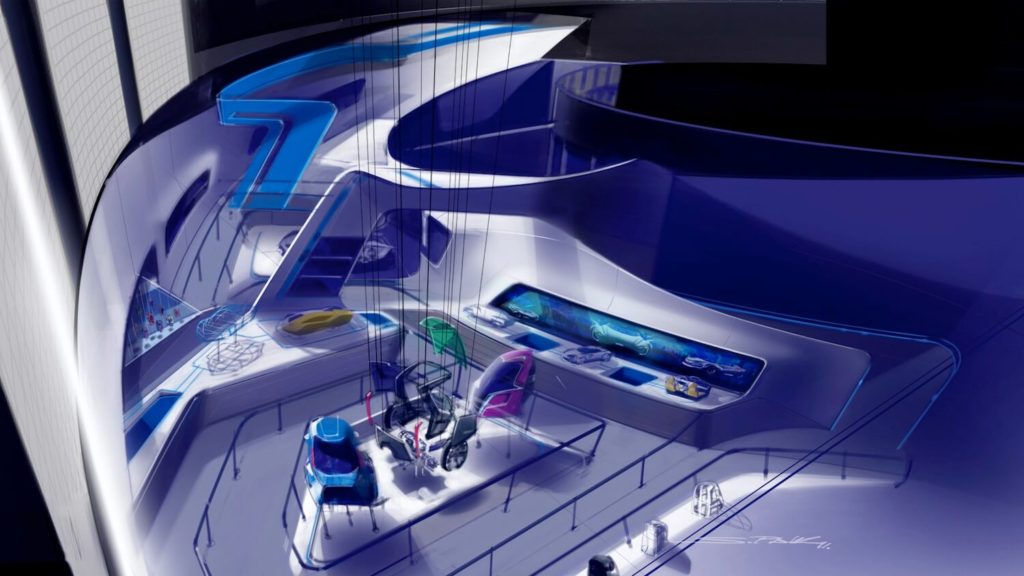
The Chevrolet EN-V is a two-seat urban electric concept car developed jointly by GM and Segway. The Chevrolet Tru looks more like something out of our world, even if it’s sleek, slim, and glistening as it rotates in the glowing queue.
As you wait, you’ll pass dimensional screens showcasing new designs and pass a projection-mapped hybrid of the future, watching as it begins with simple lines before expanding into a three-dimensional design. All the while, Chevrolet’s design team discusses how they go about developing vehicle concepts to power the future.
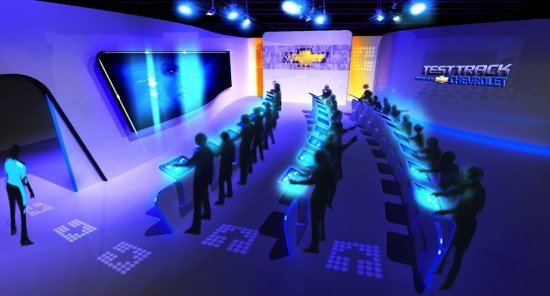
But here’s where the new Test Track really begins to shine: you’ll next enter into the Chevrolet Design Studio, a vibrant digital laboratory where you’ll be assigned an oversized touch screen Design Station.
“All designs begin with a line.” And with a swipe of your finger, you – yes, you! – will create the silhouette of a custom car. You can adjust and sculpt your car’s streamlined shape in any way you like, and then adjust the engine, tires, width, and length of your vehicle in a literally endless assortment of design options.
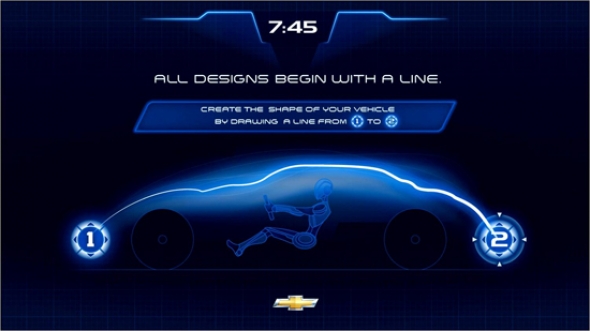
All the while, live readouts will tell you how your design handles in four key areas that matter to Chevrolet and to consumers: Capability, Efficiency, Responsiveness, and Power. Balance your car, or not! The choice is yours. And with a tap of your MagicBand or RFID-enabled park ticket, your design is assigned to you to follow you onward.
Just as before, you’ll watch as the ride vehicles pull quickly into the loading dock and park for boarding, but something’s changed. First, you’ll tap your MagicBand again before entering, assigning your custom design to the vehicle in front of you. Second of all, the yellow-and-black warning stripes are no more. The car before you is wrapped in a glowing blue grid – an indication that more than just the queue has changed.
Capability, Efficiency, Responsiveness, and Power
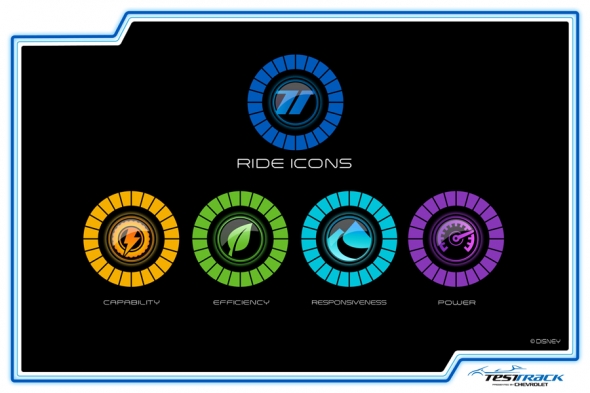
Here’s the story: every square inch of Test Track has been entirely designed. The warehouse is gone. You’re no longer in an industrial proving ground. You’re not a crash test dummy. Now, you’re a designer.
The car has been re-wrapped from a warning-striped test vehicle to a pixelated blue – a mere digital placeholder. You’ve used science, technology, engineering, art, and mathematics to construct a car worth testing, and the vehicle you’re sitting in – the SimCar – will stand in for your design on the digital SimTrack. Your custom concept will be put to the test in four test realms: Capability, Efficiency, Responsiveness, and Power.
Leaving the station, you ascend into the glowing, pulsing, digital landscape of the SimTrack, clearly (and successfully) modeled after the world of TRON. A stylized world of laser grids, you’ll track your vehicle’s progress through the four tests and view your vehicle’s real-time results after each.

At the top of the ride’s ascent, you’ll pass under a pulsing yellow digital arch – Capability – and explore your vehicle’s reactions to challenging weather and surface conditions as computer landscapes digitize to change your course, gridded sheets of rain fall, and two-dimensional programmed obstacles dot the landscape along the yellow neon road.
Having tested your vehicle on this computerized terrain, a glowing screen ahead shows how your vehicle – the one you designed! – scored in Capability compared to the scores of other riders.
Then, a green arch – Efficiency – takes you through three chambers that scan your vehicle and test its aerodynamic qualities (remember how you started with a line?) and engine efficiency. “Results displayed and verified” again!
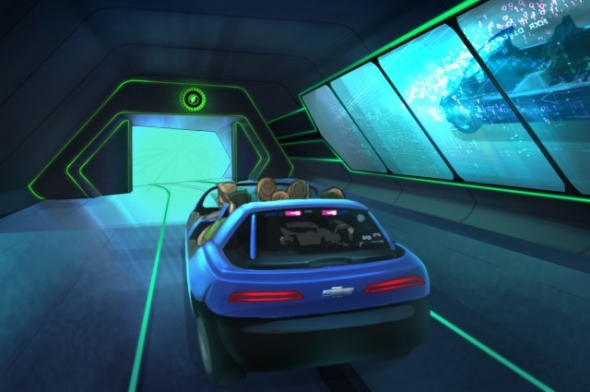
A blue arch signals the start of a Responsiveness test. As before, your vehicle tackles the tight and increasingly quick switchbacks of a hillside, though now the trees are (remarkably) produced by blue lasers and the industrial road has become a glowing neon pathway. The close encounter with a semi-truck remains, too, but it’s now created from lasers as well.
Finally, the three emblems for Capability, Efficiency, and Responsiveness ping to life, lighting up to show their completion. That leaves only one more: Power. The blue roads give way to purple arches that signal the test’s start. As lights pulse and energize, the vehicle revs and races straight toward a “TT” logo, which pulls apart at the last second, leading to the same high-speed outdoor course before seeing your vehicle’s Power test results before your eyes.
As an added bonus today, we’ll include a must-see point-of-view of the new Test Track. We’d ask you to spot the differences, but it’d probably be easier to see if there’s anything that remained the same between versions… Check it out here:
Swapping industrial infrastructure for a neon computer world, the “new” Test Track looks and feels like a completely new ride. Only after seeing this digital age reincarnation is it clear why Disney bothered t make the change at all. And now, recieving your personal vehicle’s score in Power, the experience isn’t really over.
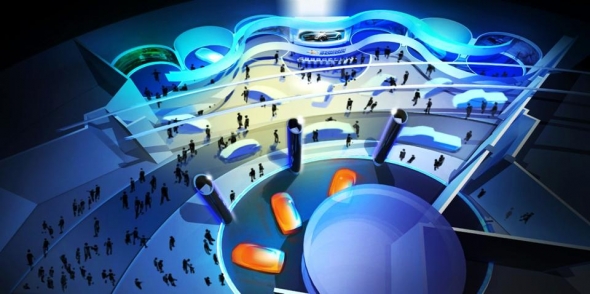
And now more than ever, you may wish to spend some time in the Test Track post-show presented by Chevrolet. Sure, you’ll see more of GM’s custom cars of the future. But this experience also lets you put your custom concept car to additional tests and trace its path through the ride one test at a time.
Think you can create a better car next time? The perfect balance of capability, efficiency, responsiveness, and power? Ride it again and give it a try. If so, there may be a job waiting for you at Chevrolet…
So really, just one question remains: which version of Test Track is better? Well… Read on to hear our thoughts…


